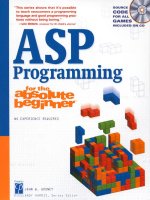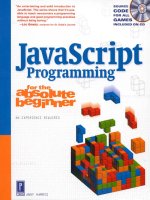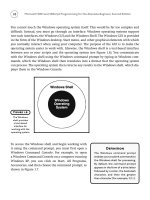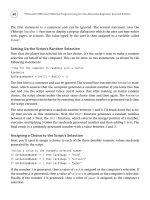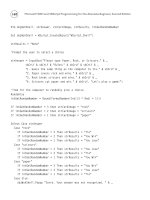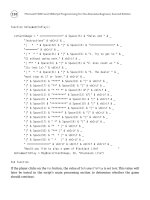C Programming for the Absolute Beginner phần 9 pot
Bạn đang xem bản rút gọn của tài liệu. Xem và tải ngay bản đầy đủ của tài liệu tại đây (14.96 MB, 33 trang )
After studying the preceding program and Figure 10.5, you can see that
realloc()
is quite
useful for expanding contiguous memory while preserving original memory contents.
CHAPTER PROGRAM—MATH QUIZ
Shown in Figure 10.6, the Math Quiz game uses memory allocation techniques, such as the
calloc()
and
free()
functions, to build a fun and dynamic quiz that tests the player’s ability
to answer basic addition problems. After studying the Math Quiz program, you can use your
own dynamic memory allocation and random number techniques to build fun quiz programs
of any nature.
FIGURE 10.6
Using chapter-
based concepts to
build the Math
Quiz.
All of the code required to build the Math Quiz game is demonstrated next.
#include <stdio.h>
#include <stdlib.h>
#include <time.h>
main()
{
int response;
int *answer;
int *op1;
int *op2;
char *result;
int x;
Chapter 10 • Dynamic Memory Allocation
241
srand(time(NULL));
printf("\nMath Quiz\n\n");
printf("Enter # of problems: ");
scanf("%d", &response);
/* Based on the number of questions the user wishes to take,
allocate enough memory to hold question data. */
op1 = (int *) calloc(response, sizeof(int));
op2 = (int *) calloc(response, sizeof(int));
answer = (int *) calloc(response, sizeof(int));
result = (char *) calloc(response, sizeof(char));
if ( op1 == NULL || op2 == NULL || answer == NULL || result == NULL ) {
printf("\nOut of Memory!\n");
return;
} // end if
//display random addition problems
for ( x = 0; x < response; x++ ) {
op1[x] = rand() % 100;
op2[x] = rand() % 100;
printf("\n%d + %d = ", op1[x], op2[x]);
scanf("%d", &answer[x]);
if ( answer[x] == op1[x] + op2[x] )
result[x] = 'c';
else
242
C Programming for the Absolute Beginner, Second Edition
result[x] = 'i';
} // end for loop
printf("\nQuiz Results\n");
printf("\nQuestion\tYour Answer\tCorrect\n");
//print the results of the quiz
for ( x = 0; x < response; x++ ) {
if ( result[x] == 'c' )
printf("%d + %d\t\t%d\t\tYes\n", op1[x], op2[x], answer[x]);
else
printf("%d + %d\t\t%d\t\tNo\n", op1[x], op2[x], answer[x]);
} //end for loop
//free memory
free(op1);
free(op2);
free(answer);
free(result);
} // end main
SUMMARY
• Random access memory (RAM) provides a volatile solution for allocating, storing, and
retrieving data. RAM is considered volatile because of its inability to store data after the
computer loses power (shuts down).
• Another volatile memory storage area called virtual memory is a reserved section of the
hard disk in which the operating system can swap memory segments.
• Virtual memory is not as efficient as random access memory, but it does provide an
impression to the CPU that is has more memory that it really does.
Chapter 10 • Dynamic Memory Allocation
243
• Used for storing variable and parameter contents, memory stacks are dynamic group-
ings of memory that grow and shrink as each program allocates and de-allocates
memory.
• The heap is an area of unused memory managed by the operating system.
•The
sizeof
operator takes a variable name or data type as an argument and returns the
number of bytes required to store the data in memory.
•The
sizeof
operator can also be used to determine the memory requirements of arrays.
•The
malloc()
function attempts to retrieve designated memory segments from the heap
and returns a pointer that is the starting point for the memory reserved.
•The
malloc()
function returns a null pointer if it is unsuccessful in allocating memory.
• Individual memory segments acquired by
malloc()
can be treated much like array mem-
bers; these memory segments can be referenced with indexes.
•The
free()
function takes a pointer as an argument and frees the memory the pointer
refers to.
• Like the
malloc()
function, the
calloc()
function attempts to grab contiguous segments
of memory from the heap. The
calloc()
function takes two arguments: the first deter-
mines the number of memory segments needed and the second is the size of the data
type.
• The main benefit of using
calloc()
rather than
malloc()
is
calloc()
’s ability to initialize
each memory segment allocated.
•The
realloc()
function provides a feature for expanding contiguous blocks of memory
while preserving the original contents.
244
C Programming for the Absolute Beginner, Second Edition
Challenges
1. Create a program that uses
malloc()
to allocate a chunk of
memory to hold a string no larger than 80 characters. Prompt
the user to enter his favorite movie. Read his response with
scanf()
and assign the data to your newly allocated memory.
Display the user’s favorite movie back to standard output.
2. Using the
calloc()
function, write a program that reads a user’s
name from standard input. Use a loop to iterate through the
memory allocated counting the number of characters in the
user’s name. The loop should stop when a memory segment is
reached that was not used in reading and storing the user’s
name. (Remember,
calloc()
initializes all memory allocated.)
Print to standard output the number of characters in the user’s
name.
3. Create a phone book program that allows users to enter names
and phone numbers of friends and acquaintances. Create a
structure to hold contact information and use
calloc()
to
reserve the first memory segment. The user should be able to
add or modify phone book entries through a menu. Use the
realloc()
function to add contiguous memory segments to the
original memory block when a user adds a new phone book
entry.
Chapter 10 • Dynamic Memory Allocation
245
This page intentionally left blank
11
C HAP TE R
FILE INPUT AND OUTPUT
n this chapter, I will show you how to open, read, and write information
to data files using functions from the standard input/output (
<stdio.h>
)
library. You will also learn essential data file hierarchy concepts and how
C uses file streams to manage data files.
Specifically, this chapter covers the following topics:
• Introduction to data files
• File streams
•
goto
and error handling
I
NTRODUCTION TO
D
ATA
F
ILES
Assuming you’ve been reading the chapters of this book in order, you’ve already
learned the basics of utilizing C and volatile memory storage devices for saving,
retrieving, and editing data. Specifically, you know that variables are used to
manage data in volatile memory areas, such as random access memory and
virtual memory, and that memory can be dynamically obtained for temporarily
storing data.
Despite the obvious importance of volatile memory such as RAM, it does have its
drawbacks when it comes to long-term data storage. When data needs to be
archived or stored in nonvolatile memory areas such as a hard disk, programmers
I
look to data files as a viable answer for storing and retrieving data after the computer’s power
has been turned off.
Data files are often text-based and are used for storing and retrieving related information like
that stored in a database. Managing the information contained in data files is up to the
C programmer. In order to understand how files can be managed, I will introduce you
to beginning concepts that are used to build files and record layouts for basic data file
management.
It’s important to understand the breakdown and hierarchy of data files, because each com-
ponent (parent) and sub component (child) are used together to create the whole. Without
each component and its hierarchical relationships, building more advanced data file systems
such as relational databases would be difficult.
A common data file hierarchy is typically broken down into five categories as described in
Table 11.1.
T
ABLE
11.1 D
ATA
F
ILE
H
IERARCHY
Entity Description
Bit Binary digit, 0 or 1
Byte Eight characters
Field Grouping of bytes
Record Grouping of fields
File Grouping of records
Bits and Bytes
Also known as binary digits, bits are the smallest value in a data file. Each bit value can only
be a 0 or 1. Because bits are the smallest unit of measurement in computer systems, they
provide an easy mechanism for electrical circuits to duplicate 1s and 0s with patterns of off
and on electrical states. When grouped together, bits can build the next unit of data man-
agement, known as bytes.
Bytes provide the next step in the data file food chain. Bytes are made up of eight bits and are
used to store a single character, such as a number, a letter, or any other character found in a
character set. For example, a single byte might contain the letter M, the number 7, or a key-
board character such as the exclamation point (!). Together, bytes make up words or, better
yet, fields.
248
C Programming for the Absolute Beginner, Second Edition
Fields, Records, and Files
In database or data-file lingo, groupings of characters are most commonly referred to as
fields. Fields are often recognized as placeholders on a graphical user interface (GUI), but are
really a data concept that groups characters in a range of sizes and data types to provide
meaningful information. Fields could be a person’s name, social security number, street
address, phone number, and so on. For example, the name “Sheila” could be a value stored
in a field called First Name. When combined in a logical group, fields can be used to express
a record of information.
Records are logical groupings of fields that comprise a single row of information. Each field
in a record describes the record’s attributes. For example, a student record might be com-
prised of name, age, ID, major, and GPA fields. Each field is unique in description but together
describes a single record.
Individual fields in records are sometimes separated or delimited using spaces, tabs, or com-
mas as shown in the next sample record that lists field values for a single student.
Sheila Vine, 29, 555-55-5555, Computer Science, 4.0
Together, records are stored in data files.
Data files are comprised of one or more records and are at the top of the data file food chain.
Each record in a file typically describes a unique collection of fields. Files can be used to store
all types of information, such as student or employee data. Data files are normally associated
with various database processes in which information can be managed in nonvolatile states,
such as a local disk drive, USB flash device, or web server. An example data file called
students.dat
with comma-delimited records is shown next.
Michael Vine, 30, 222-22-2222, Political Science, 3.5
Sheila Vine, 29, 555-55-5555, Computer Science, 4.0
Spencer Vine, 19, 777-77-7777, Law, 3.8
Olivia Vine, 18, 888-88-8888, Medicine, 4.0
F
ILE
S
TREAMS
C programmers use pointers to manage streams that read and write data. Understanding
streams is quite easy. In fact, streams are just file or hardware devices, such as a monitor or
printer, which can be controlled by C programmers using pointers to the stream.
Chapter 11 • File Input and Output
249
Pointers, pointers, and more pointers! You know you love them, or at least by now love to
hate them. As you may have guessed, anything worth doing in C involves pointers. And of
course data files are no exception.
To point to and manage a file stream in C, simply use an internal data structure called
FILE
. Pointers of type
FILE
are created just like any other variable, as the next program
demonstrates.
#include <stdio.h>
main()
{
//create 3 file pointers
FILE *pRead;
FILE *pWrite;
FILE *pAppend;
} //end main
As you can see, I created three
FILE
pointer variables called
pRead
,
pWrite
, and
pAppend
. Using
a series of functions that I will show you soon, each
FILE
pointer can open and manage a
separate data file.
Opening and Closing Files
The basic components for file processing involve opening, processing, and closing data files.
Opening a data file should always involve a bit of error checking and/or handling. Failure to
test the results of a file-open attempt will sometimes cause unwanted program results in
your software.
To open a data file, use the standard input/output library function
fopen()
. The
fopen()
func-
tion is used in an assignment statement to pass a
FILE
pointer to a previously declared
FILE
pointer, as the next program reveals.
#include <stdio.h>
main()
{
FILE *pRead;
250
C Programming for the Absolute Beginner, Second Edition
pRead = fopen("file1.dat", "r");
} //end main
This program uses the
fopen()
function to open a data file, called
file1.dat
, in a read-only
manner (more on this in a moment). The
fopen()
function returns a
FILE
pointer back to the
pRead
variable.
Data File Extensions
It is common to name data files with a
.dat
extension, although it is not required. Many data
files used for processing information have other extensions, such as
.txt
for text files,
.csv
for comma separated value files,
.ini
for initialization files, or
.log
for log files.
You can create your own data file programs that use file extensions of your choice. For example,
I could write my own personal finance software program that opens, reads, and writes to a data
file called
finance.mpf
, in which
.mpf
stands for Michael’s personal finance.
As demonstrated in the previous program, the
fopen()
function takes two arguments: the
first supplies
fopen()
with the file name to open, and the second argument tells
fopen()
how
to open the file.
Table 11.2 depicts a few common options for opening text files using
fopen()
.
T
ABLE
11.2 C
OMMON
T
EXT
F
ILE
O
PEN
M
ODES
Mode Description
r
Opens file for reading
w
Creates file for writing; discards any previous data
a
Writes to end of file (append)
After opening a file, you should always check to ensure that the
FILE
pointer was returned
successfully. In other words, you want to check for occasions when the specified file name
cannot be found. Does the Window’s error “Disk not ready or File not found” sound familiar?
To test
fopen()
’s return value, test for a
NULL
value in a condition, as demonstrated next.
Chapter 11 • File Input and Output
251
#include <stdio.h>
main()
{
FILE *pRead;
pRead = fopen("file1.dat", "r");
if ( pRead == NULL )
printf("\nFile cannot be opened\n");
else
printf("\nFile opened for reading\n");
} //end main
The following condition
if ( pRead == NULL )
can be shortened with the next condition.
if ( pRead )
If
pRead
returns a non-
NULL
, the
if
condition is true. If
pRead
returns
NULL
, the
condition is false.
After successfully opening and processing a file, you should close the file using a function
called
fclose()
. The
fclose()
function uses the
FILE
pointer to flush the stream and close the
file. As shown next, the
fclose()
function takes a
FILE
pointer name as an argument.
fclose(pRead);
In sections to come, I will show you more of the
fopen()
and
fclose()
functions and how they
can be used for managing the reading, writing, and appending of information in data files.
TIP
252
C Programming for the Absolute Beginner, Second Edition
Reading Data
You can easily create your own data files using common text editors such as vi, nano, or even
Microsoft’s Notepad. If you’re using a Microsoft Windows operating system, you can also use
a Microsoft DOS-based system function called
copy con
, which copies text entered via the
keyboard into a predetermined file. The
copy con
process copies text entered from the console
and appends an end-of-file marker using Ctrl+Z, as demonstrated in Figure 11.1.
F
IGURE
11.1
Using Microsoft’s
copy con process
to create a data
file.
To read a data file, you will need to investigate a few new functions. Specifically, I will show
you how to read a file’s contents and check for the file’s EOF (end-of-file) marker using the
functions
fscanf()
and
feof()
.
To demonstrate, study the following program that reads a data file called
names.dat
until an
end-of-file marker is read. The output is shown in Figure 11.2.
#include <stdio.h>
main()
{
FILE *pRead;
char name[10];
pRead = fopen("names.dat", "r");
if ( pRead == NULL )
printf("\nFile cannot be opened\n");
Chapter 11 • File Input and Output
253
else
printf("\nContents of names.dat\n\n");
fscanf(pRead, "%s", name);
while ( !feof(pRead) ) {
printf("%s\n", name);
fscanf(pRead, "%s", name);
} //end loop
} //end main
F
IGURE
11.2
Reading
information from
a data file.
After successfully opening
names.dat
, I use the
fscanf()
function to read a single field within
the file. The
fscanf()
function is similar to the
scanf()
function but works with
FILE
streams
and takes three arguments: a
FILE
pointer, a data type, and a variable to store the retrieved
value in. After reading the record, I can use the
printf()
function to display data from the file.
Most data files contain more than one record. To read multiple records, it is common to use
a looping structure that can read all records until a condition is met. If you want to read all
records until the end-of-file is met, the
feof()
function provides a nice solution. Using the
not operator (!), you can pass the
FILE
pointer to the
feof()
function and loop until the func-
tion returns a non-zero value when an end-of-file marker is reached.
fscanf()
can also read records containing multiple fields by supplying to the second argu-
ment a series of type specifiers for each field in the record. For example, the next
fscanf()
function expects to read two character strings called
name
and
hobby
.
254
C Programming for the Absolute Beginner, Second Edition
fscanf(pRead, "%s%s", name, hobby);
The
%s
type specifier will read a series of characters until a white space is found, including
blank, new line, or tab.
Other valid type specifiers you can use with the
fscanf()
function are listed in Table 11.3.
T
ABLE
11.3
FSCANF
() T
YPE
S
PECIFIERS
Type Description
c Single character
d Decimal integer
e, E, f, g, G Floating point
o Octal integer
s String of characters
u Unsigned decimal integer
x, X Hexadecimal integer
To demonstrate how a file containing records with multiple fields is read, study the next
program and its output in Figure 11.3.
#include <stdio.h>
main()
{
FILE *pRead;
char name[10];
char hobby[15];
pRead = fopen("hobbies.dat", "r");
if ( pRead == NULL )
printf("\nFile cannot be opened\n");
else
Chapter 11 • File Input and Output
255
printf("\nName\tHobby\n\n");
fscanf(pRead, "%s%s", name, hobby);
while ( !feof(pRead) ) {
printf("%s\t%s\n", name, hobby);
fscanf(pRead, "%s%s", name, hobby);
} //end loop
} //end main
F
IGURE
11.3
Reading records in
a data file with
multiple fields.
Writing Data
Writing information to a data file is just as easy as reading data. In fact, you can use a function
similar to
printf()
called
fprintf()
that uses a
FILE
pointer to write data to a file. The
fprintf()
function takes a
FILE
pointer, a list of data types, and a list of values (or variables) to write
information to a data file, as demonstrated in the next program and in Figure 11.4.
#include <stdio.h>
main()
{
FILE *pWrite;
char fName[20];
char lName[20];
256
C Programming for the Absolute Beginner, Second Edition
char id[15];
float gpa;
pWrite = fopen("students.dat", "w");
if ( pWrite == NULL )
printf("\nFile not opened\n");
else {
printf("\nEnter first name, last name, id and GPA\n\n");
printf("Enter data separated by spaces: ");
//store data entered by the user into variables
scanf("%s%s%s%f", fName, lName, id, &gpa);
//write variable contents separated by tabs
fprintf(pWrite, "%s\t%s\t%s\t%.2f\n", fName, lName, id, gpa);
fclose(pWrite);
} //end if
} //end main
F
IGURE
11.4
Writing a record of
information to a
data file.
Chapter 11 • File Input and Output
257
In the preceding program I ask the user to enter student information. Each piece of informa-
tion is considered a field in the record and is separated during input with a single space
character. In other words, I am able to read an entire line of data using a single
scanf()
function with the user entering multiple pieces of data separated by spaces. After reading
each field of data, I use the
fprintf()
function to write variables to a data file called
students.dat
. By separating each field in the record with a tab (I’ve created a tab-delimited
file), I can easily read the same record back with the following program.
#include <stdio.h>
main()
{
FILE *pRead;
char fName[20];
char lName[20];
char id[15];
float gpa;
pRead = fopen("students.dat", "r");
if ( pRead == NULL )
printf("\nFile not opened\n");
else {
//print heading
printf("\nName\t\tID\t\tGPA\n\n");
//read field information from data file and store in variables
fscanf(pRead, "%s%s%s%f", fName, lName, id, &gpa);
//print variable data to standard output
printf("%s %s\t%s\t%.2f\n", fName, lName, id, gpa);
258
C Programming for the Absolute Beginner, Second Edition
fclose(pRead);
} //end if
} //end main
Figure 11.5 shows the output of reading the tab-delimited file created in the preceding code.
F
IGURE
11.5
Reading
information from
a data file created
by the fprintf()
function.
Keep in mind that opening a data file using
fopen()
with a
w
argument value will erase any
previous data stored in the file. Use the
a
attribute to append data at the end of the file, as
discussed in the next section.
Appending Data
Appending data is a common process among Information Technology (IT) professionals
because it allows programmers to continue building upon an existing file without deleting
or removing previously stored data.
attribute in an
fopen()
function and writing records or data to the end of an existing file. If
the file does not exist, however, a new data file is created as specified in the
fopen()
statement.
Study the following program, which demonstrates appending records to an existing data file.
#include <stdio.h>
void readData(void);
main()
Chapter 11 • File Input and Output
259
Appending information to a data file involves opening a data file for writing using the
a
{
FILE *pWrite;
char name[10];
char hobby[15];
printf("\nCurrent file contents:\n");
readData();
printf("\nEnter a new name and hobby: ");
scanf("%s%s", name, hobby);
//open data file for append
pWrite = fopen("hobbies.dat", "a");
if ( pWrite == NULL )
printf("\nFile cannot be opened\n");
else {
//append record information to data file
fprintf(pWrite, "%s %s\n", name, hobby);
fclose(pWrite);
readData();
} //end if
} //end main
void readData(void)
{
FILE *pRead;
char name[10];
260
C Programming for the Absolute Beginner, Second Edition
char hobby[15];
//open data file for read access only
pRead = fopen("hobbies.dat", "r");
if ( pRead == NULL )
printf("\nFile cannot be opened\n");
else {
printf("\nName\tHobby\n\n");
fscanf(pRead, "%s%s", name, hobby);
//read records from data file until end of file is reached
while ( !feof(pRead) ) {
printf("%s\t%s\n", name, hobby);
fscanf(pRead, "%s%s", name, hobby);
} //end loop
} //end if
fclose(pRead);
} //end readData
With a user-defined function called
readData()
, I’m able to open the
hobbies.dat
data file
created earlier and read each record until the end-of-file is encountered. After the
readData()
function is finished, I prompt the user to enter another record. After successfully writing the
user’s new record to the data file, I once again call the
readData()
function to print again all
records, including the one added by the user. Figure 11.6 depicts the process of appending
information to data files using the preceding program.
Chapter 11 • File Input and Output
261
F
IGURE
11.6
Appending
records to a data
file.
GOTO AND
E
RROR
H
ANDLING
Whenever your program interacts with the outside world, you should provide some form of
error handling to counteract unexpected inputs or outputs. One way of providing error han-
dling is to write your own error-handling routines.
Error-handling routines are the traffic control for your program. Such routines should ideally
consider the multitude of programming and human-generated error possibilities, resolve
issues if possible, and at the very least exit the program gracefully after an error.
A Brief History of goto
The
goto
keyword is a carryover from an old programming practice made popular in various
languages such as BASIC, COBOL, and even C. A
goto
was regularly used for designing and
building modularized programs. To break programs into manageable pieces, programmers
would create modules and link them together using the keyword
goto
in hopes of simulating
function calls.
After years of programming with
goto
, programmers began to realize that this created messy
"spaghetti-like" code, which at times became nearly impossible to debug. Fortunately,
improvements to the structured programming paradigm and event-driven and object-oriented
programming techniques have virtually eliminated the need for
goto
.
Because of the lack of built-in exception handling within the C language, it is acceptable to
use the once infamous
goto
keyword. Specifically, if you’d like to separate out error handling
from each routine and save yourself from writing repetitive error handlers, then
goto
may be
a good alternative for you.
262
C Programming for the Absolute Beginner, Second Edition
Using
goto
is very simple: first include a label (a descriptive name) followed by a colon (
:
)
above where you want your error-handling routine to run (begin). To call your error-handling
routine (where you want to check for an error), simply use the keyword
goto
followed by the
label name as demonstrated next.
int myFunction()
{
int iReturnValue = 0; //0 for success
/* process something */
if(error)
{
goto ErrorHandler; //go to the error-handling routine
}
/* do some more processing */
if(error)
{
ret_val = [error];
goto ErrorHandler; //go to the error-handling routine
}
ErrorHandler:
/* error-handling routine */
return iReturnValue ;
}
The label in the preceding code is
ErrorHandler
, which is simply a name I came up with to
identify or label my error handler. In the same sample code, you can see that I want to check
for errors in each of the
if
constructs and if an error exists, I call my error handler using the
keyword
goto
.
Review the next programming example, with output shown in Figure 11.7, that demonstrates
the use of
goto
and a couple of new functions (
perror()
and
exit()
) to build error handling
into a file I/O program.
#include <stdio.h>
#include <stdlib.h>
main()
Chapter 11 • File Input and Output
263
{
FILE *pRead;
char name[10];
char hobby[15];
pRead = fopen("hobbies.dat", "r");
if ( pRead == NULL )
goto ErrorHandler;
else {
printf("\nName\tHobby\n\n");
fscanf(pRead, "%s%s", name, hobby);
while ( !feof(pRead) ) {
printf("%s\t%s\n", name, hobby);
fscanf(pRead, "%s%s", name, hobby);
} //end loop
} // end if
exit(EXIT_SUCCESS); //exit program normally
ErrorHandler:
perror("The following error occurred");
exit(EXIT_FAILURE); //exit program with error
} //end main
264
C Programming for the Absolute Beginner, Second Edition
F
IGURE
11.7
Using perror()
and exit()
functions to
display an error
message and exit
the program.
The
exit()
function, part of the
<stdlib.h>
library, terminates a program as if it were exited
normally. As shown next, the
exit()
function is common with programmers who want to
terminate a program when encountering file I/O (input/output) errors.
exit(EXIT_SUCCESS); //exit program normally
//or
exit(EXIT_FAILURE); //exit program with error
The
exit()
function takes a single parameter, a constant of either
EXIT_SUCCESS
or
EXIT_
FAILURE
, both of which return a pre-defined value for success or failure, respectively.
The
perror()
function sends a message to standard output describing the last error encoun-
tered. The
perror()
function takes a single string argument, which is printed first, followed
by a colon and a blank, then the system generated error message and a new line, as revealed
next.
perror("The following error occurred");
C
HAPTER
P
ROGRAM
—T
HE
P
HONE
B
OOK
P
ROGRAM
The Phone Book program shown in Figure 11.8 uses many chapter-based concepts, including
fields, records, data files,
FILE
pointers, and error handling, to build a simple electronic phone
book. Specifically, the Phone Book program allows a user to add phone book entries and print
the contents of the entire phone book.
After reading this chapter and studying the code from the Phone Book program, you should
be able to build your own programs that use data files to store all kinds of information. In
addition, you could build your own Phone Book program or make modifications to mine as
outlined in the Challenges section.
Chapter 11 • File Input and Output
265


